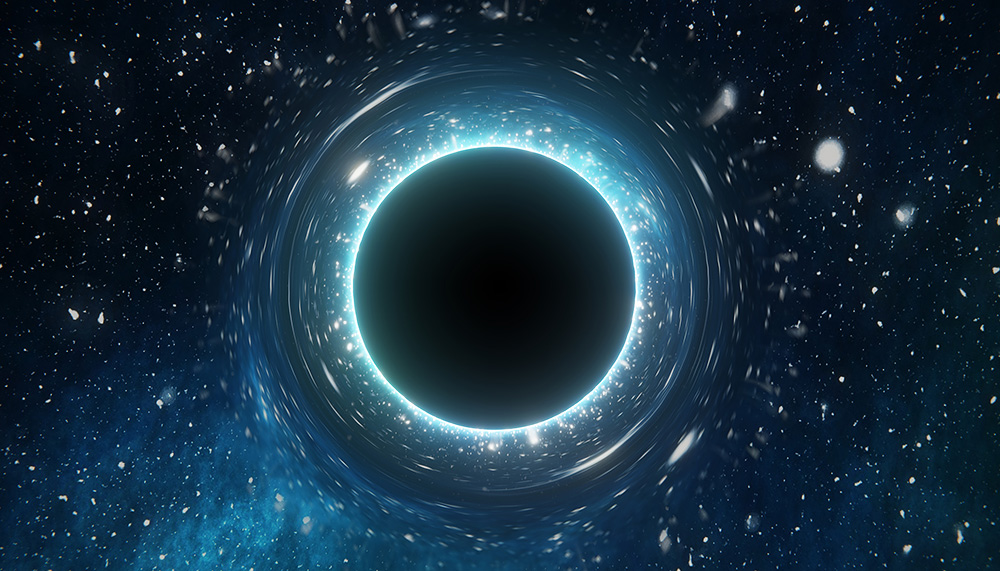Invisible heavyweight: Astronomers have discovered the most massive black hole in the Milky Way that was formed from a star. At around 33 solar masses, the object named BH3 is three times as heavy as most other stellar black holes. The new record holder is also only around 2,000 light-years away from us, making it the second closest black hole, as the team reports in “Astronomy & Astrophysics”. But how can the large mass of this heavyweight be explained?
How heavy can a stellar black hole get? So far this question has only been partially clarified. It seems clear that such objects are formed when an old, massive star explodes in a supernova. However, very heavy stars lose most of their mass as they age because strong stellar winds then pull material out into space. Even stars with more than 30 solar masses produce black holes with less than 20 solar masses – that was the previous assumption.
The previous observations also seemed to fit this: “All known stellar black holes in the Milky Way typically weigh less than ten solar masses,” explain the astronomers in the Gaia collaboration led by Pasquale Panuzzo from the Paris Observatory. The only outlier is Cygnus X-1, a binary system consisting of a massive star and a stellar black hole of around 20 solar masses.
The star orbits an invisible but very massive object. © ESO/ L. Calçada
Star orbits around invisible partner
But now Panuzzo and his team have discovered a black hole that is even heavier. The astronomers discovered the object, named BH3, when they evaluated the latest data from the European Gaia space telescope – they were actually looking for other binary star systems. They noticed a star around 2,000 light-years away that behaved as if it were orbiting a partner star: it orbited in an elliptical orbit lasting around 11.6 years.
But even after more detailed analyzes using high-resolution spectrometers from the Very Large Telescope (VLT) of the European Southern Observatory in Chile, nothing could be seen of this star’s partner. “The spectra show no sign of the presence of a second component,” report Panuzzo and his colleagues. However, the star’s orbit shape and motion suggested that the star must be orbiting a very heavy object of around 33 solar masses.
Second closest black hole
According to astronomers, there is only one explanation for this: the star orbits an inactive and therefore invisible black hole. “The mass is too large for one or two closely orbiting neutron stars,” they explain. Two black holes of lower mass closely orbiting each other are also rather unlikely due to their characteristics. The simplest and most obvious explanation is therefore a very massive stellar black hole.
“Nobody expected to find a massive black hole lurking nearby that has remained undetected,” says Panuzzo. “You only make this kind of discovery once in your research life.” At just 2,000 light-years away, BH3 is the second closest black hole to Earth. The closest specimen to us, BH1, was discovered in 2022 and is 1,560 light-years away, but is significantly lighter.
Gaia BH3 is the most massive stellar black hole yet found in the Milky Way. Here is a comparison of the previous record holder Cygnus X-1 and the closest black hole to Earth BH1. © ESO/ M. Kornmesser
Harder than theory allows?
The bottom line, however, is that BH3 is almost inexplicably heavy for a stellar black hole. “The 33 solar masses make BH3 the most massive black hole of stellar origin ever discovered in our galaxy,” the astronomers write. Only a few extragalactic black holes that astronomers have “eavesdropped” on merging using gravitational waves are similarly massive. They are also significantly heavier than, according to theory, formed in normal supernovae.
The extraordinary features of this black hole make BH3 a unique test object. “Given the uniqueness of the discovery, we have taken the extraordinary step of publishing this work based on preliminary data ahead of the upcoming Gaia data release,” says co-author Elisabetta Caffau from Observatory Paris. This also allows other astronomers to study this black hole in more detail.
Metal poverty could provide an explanation
The central question is how such a heavyweight could come into being in the first place. The astronomers may have found a first indication of this in the composition of BH3’s partner star. “Stellar black holes with more than 30 solar masses can be reconciled with the models of stellar evolution if their predecessors are particularly metal-poor,” explain Panuzzo and his team.
Such giant stars, which consist almost entirely of hydrogen and helium, produce only a weak stellar wind and therefore lose less material before their supernova. In fact, spectral analyzes of BH3’s partner star revealed that it contains few heavy elements. “This low metallicity supports the scenario that such metal-poor stars are the predecessors of massive stellar black holes,” the astronomers report. Further observations will now show whether this is the case. (Astronomy & Astrophysics, 2024; doi: 10.1051/0004-6361/202449763)
Quelle: European Southern Observatory (ESO)
April 16, 2024 – Nadja Podbregar
